Answered step by step
Verified Expert Solution
Question
1 Approved Answer
1. Complete the Dry Friction tutorial given in Appendix A from Larsen R. and Hunt S., http://www.secs.oakland.edu/-latcha/EGR280 /StatDynMatlab.pdf This tutorial will guide you through
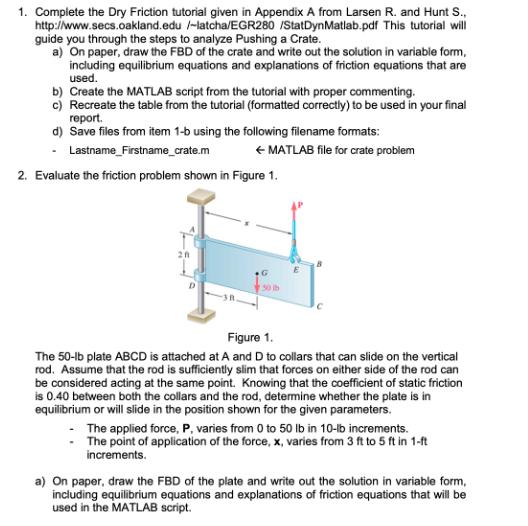
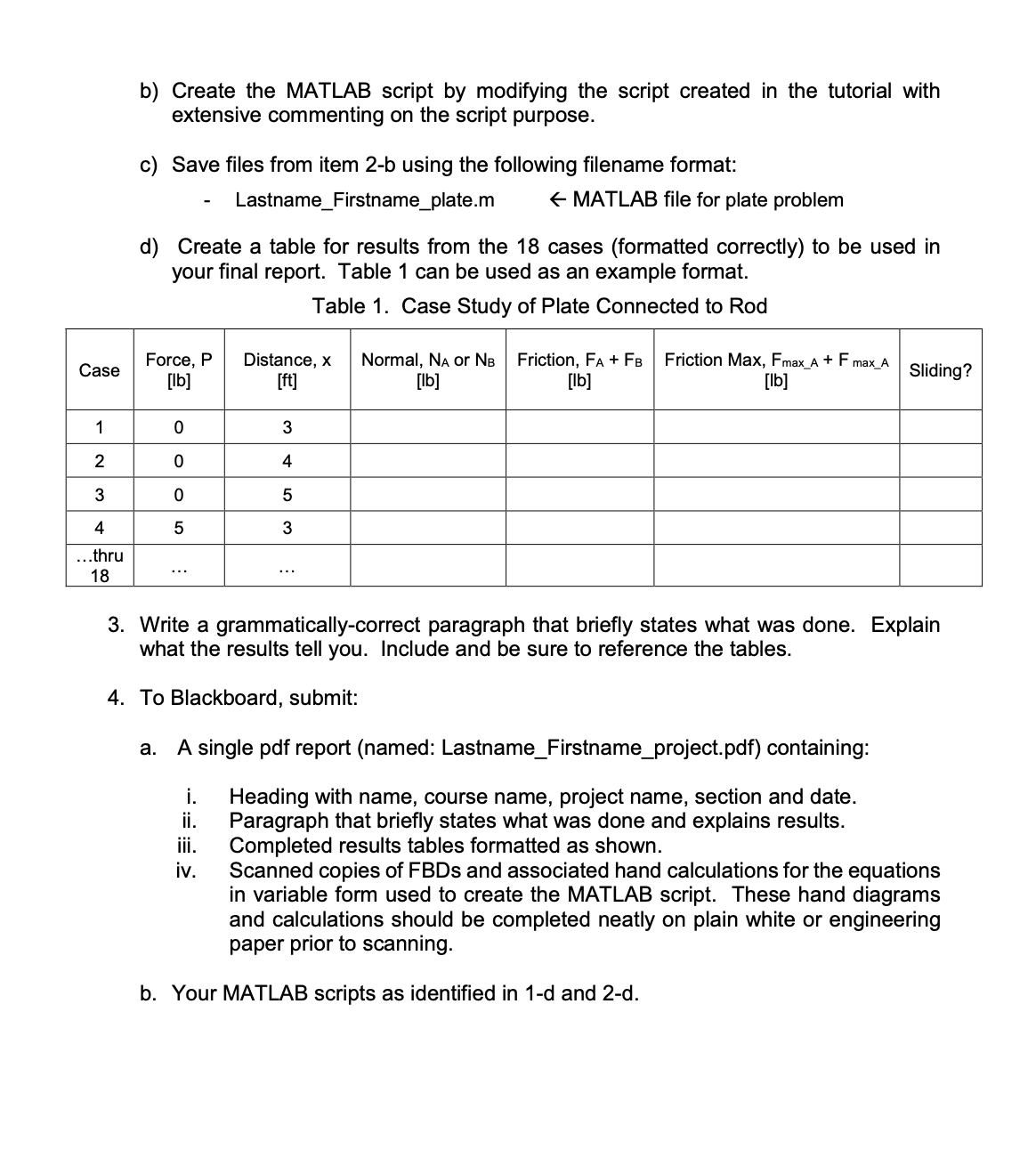
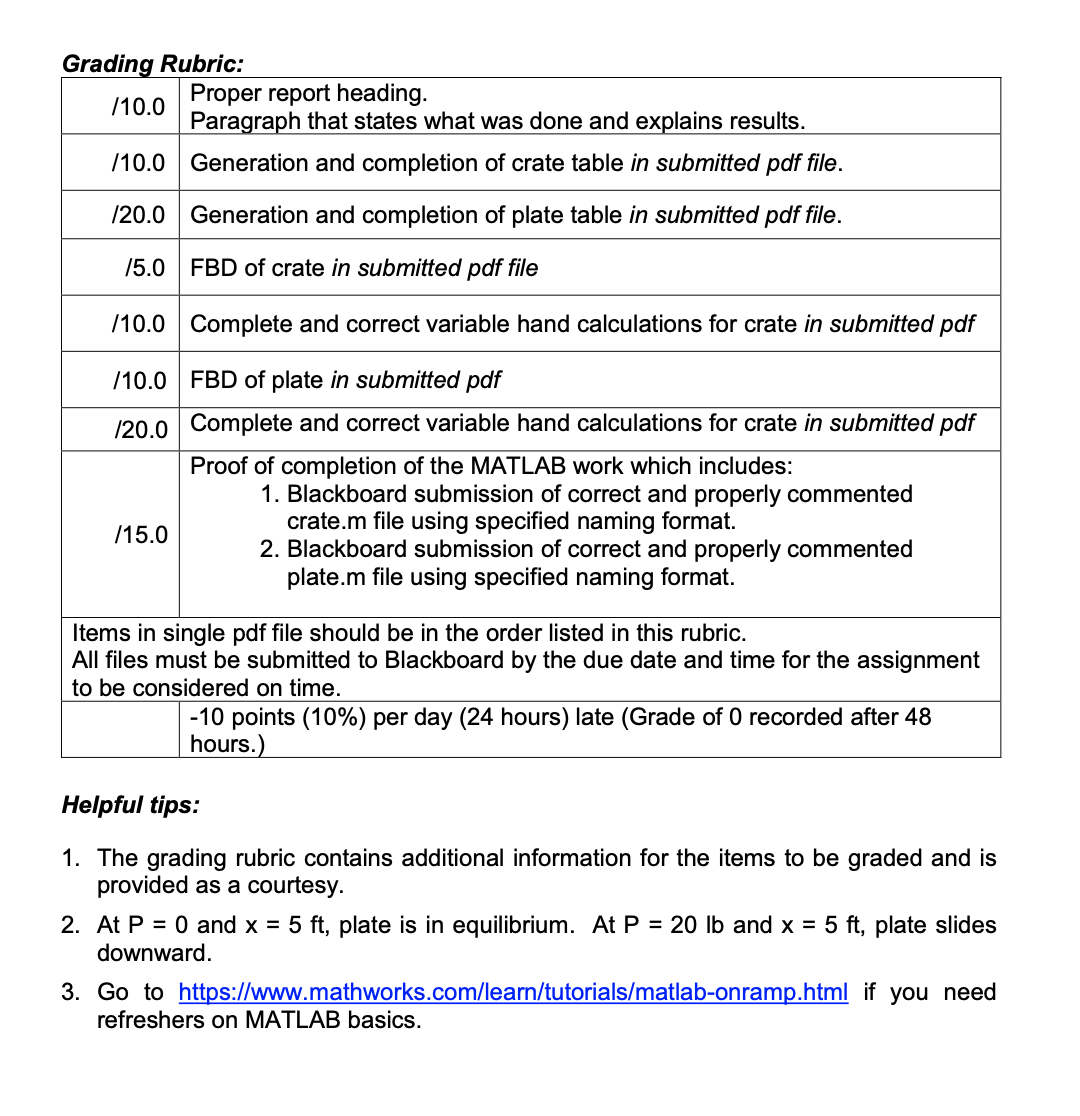
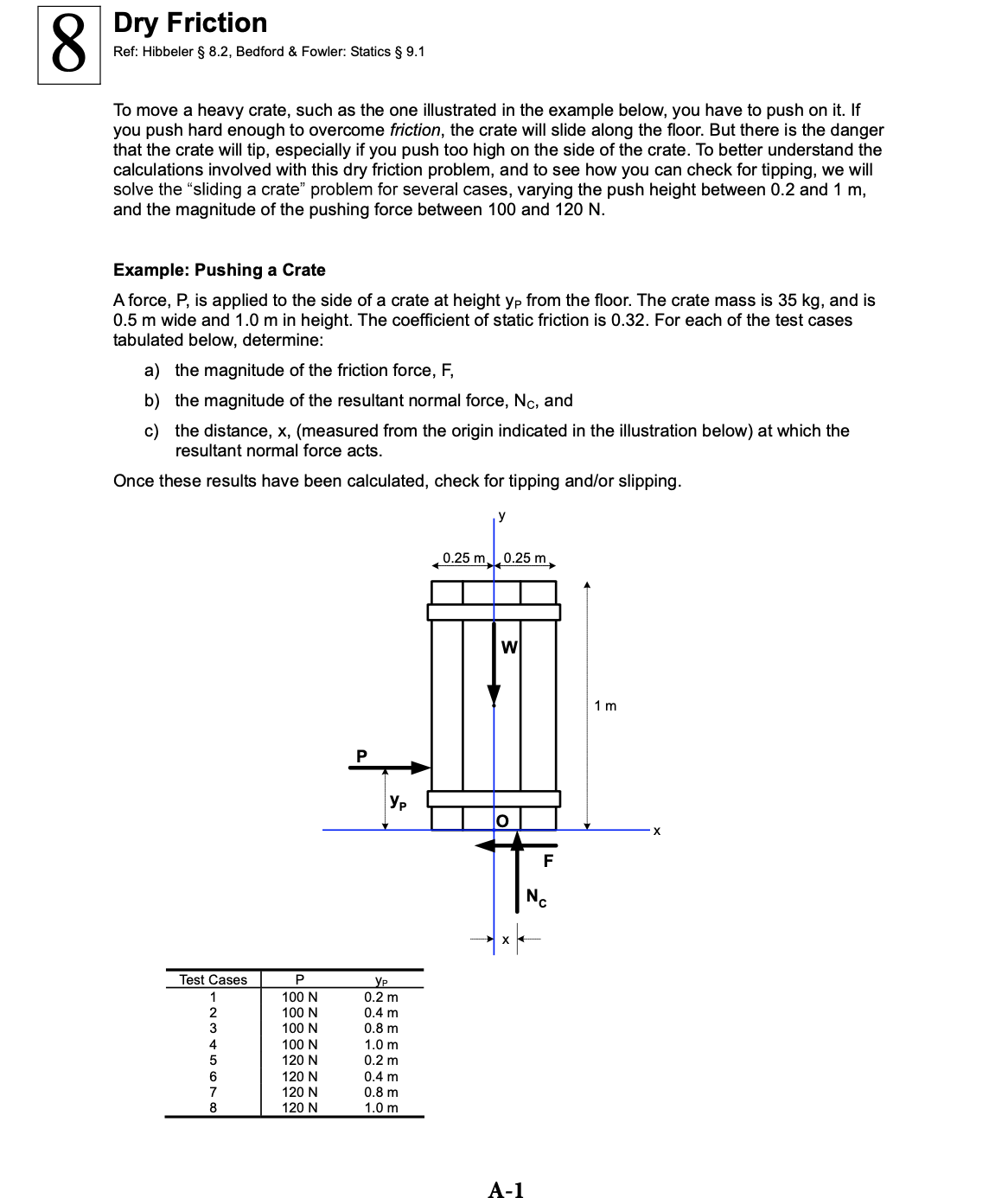
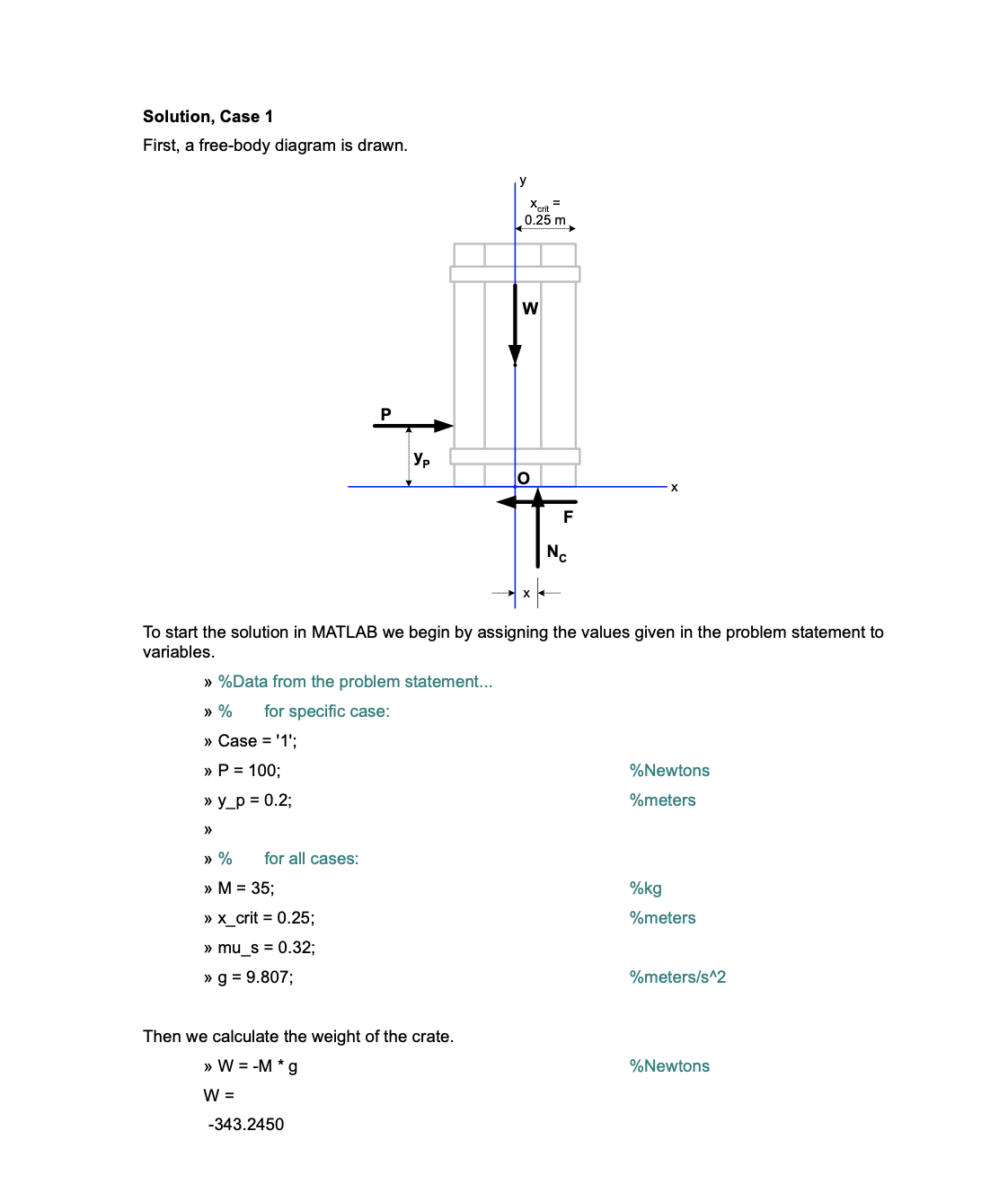
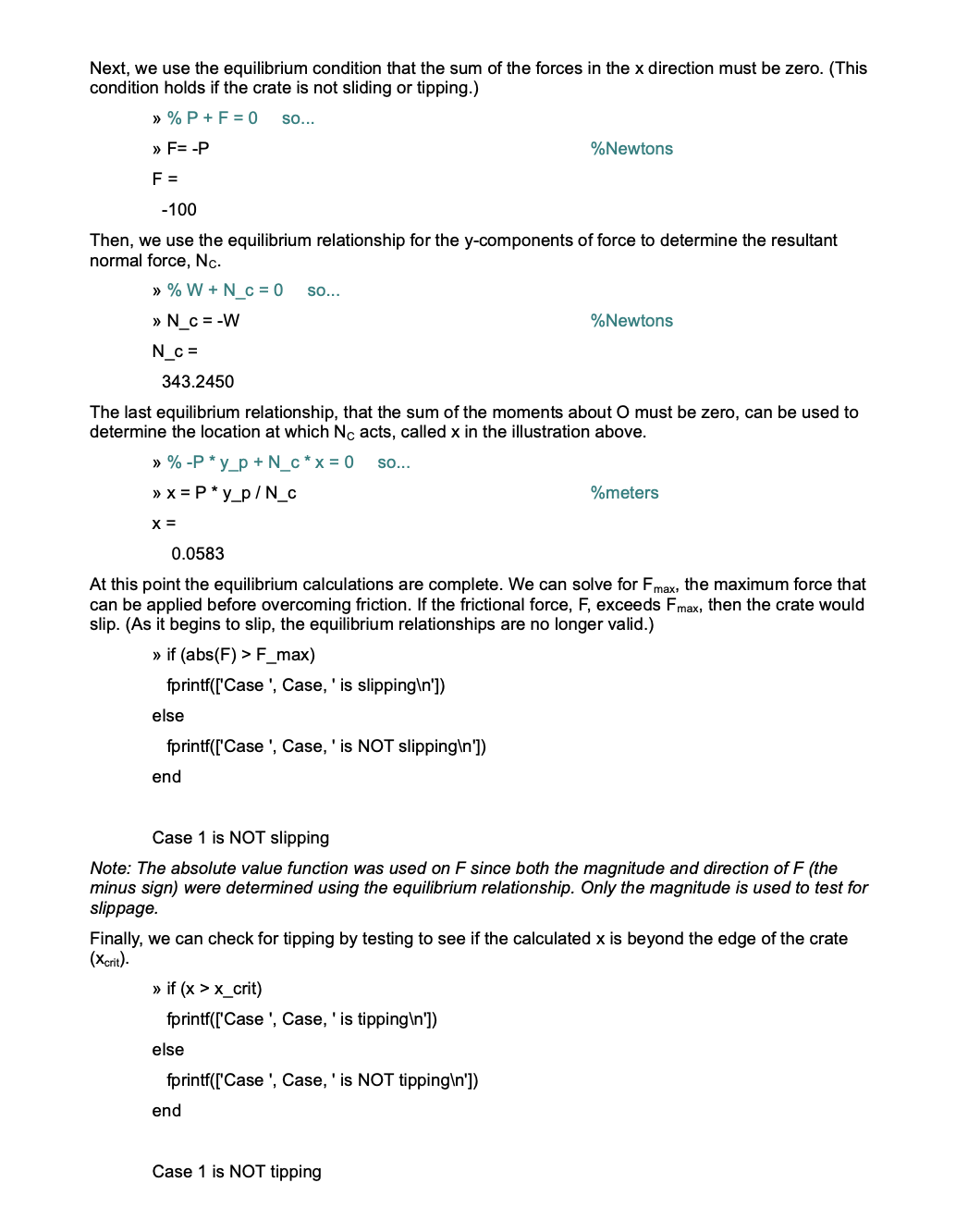
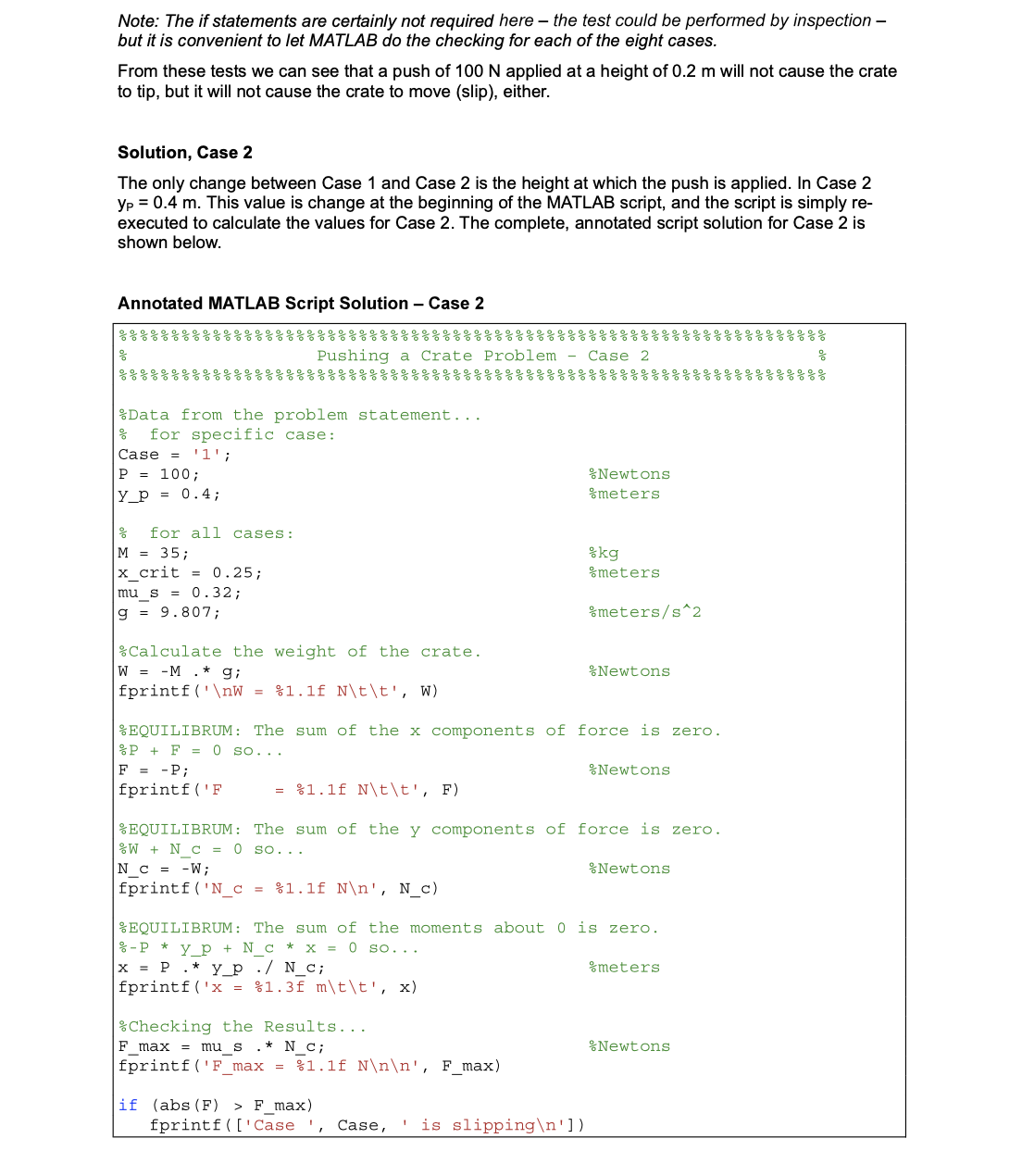
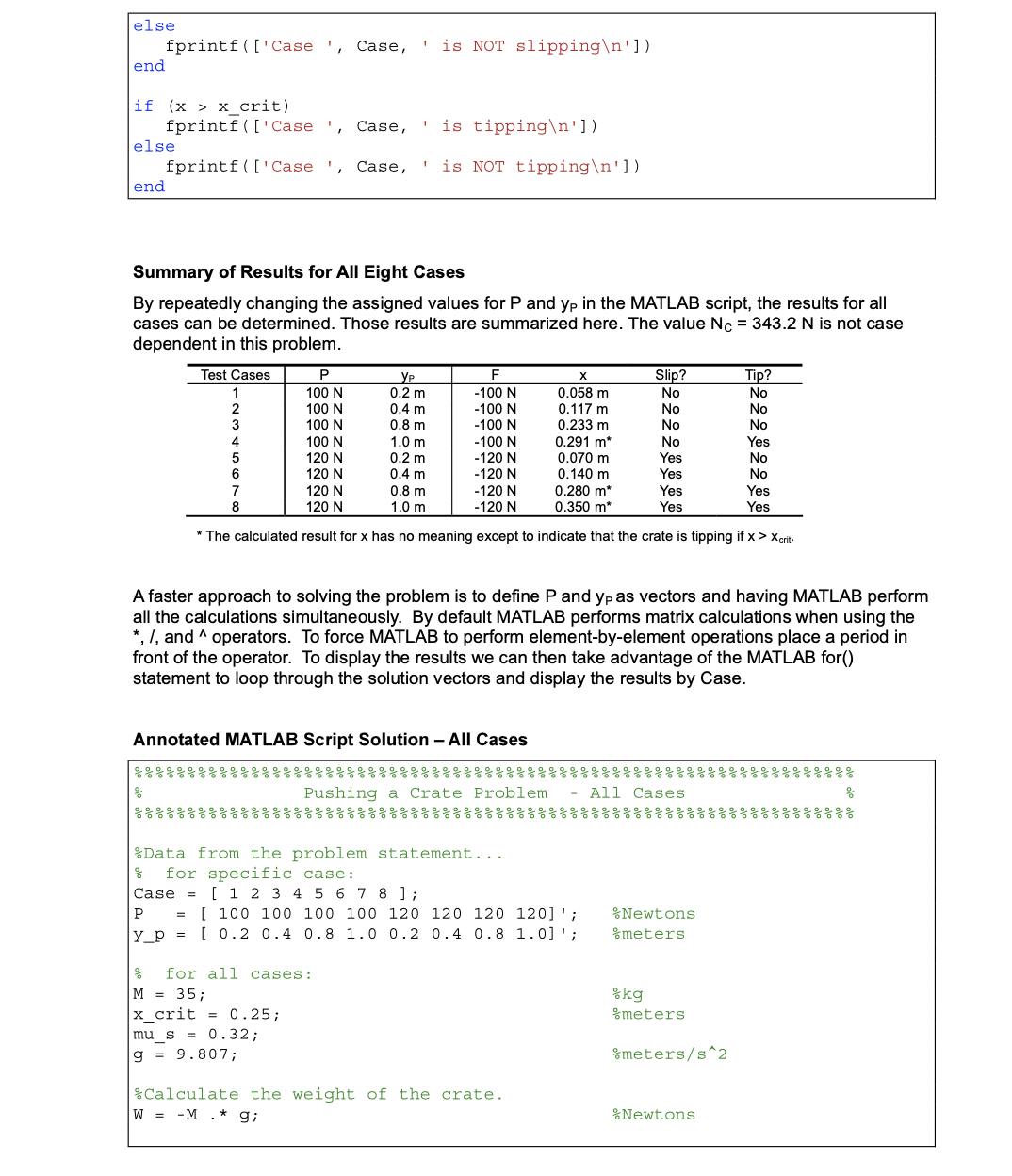
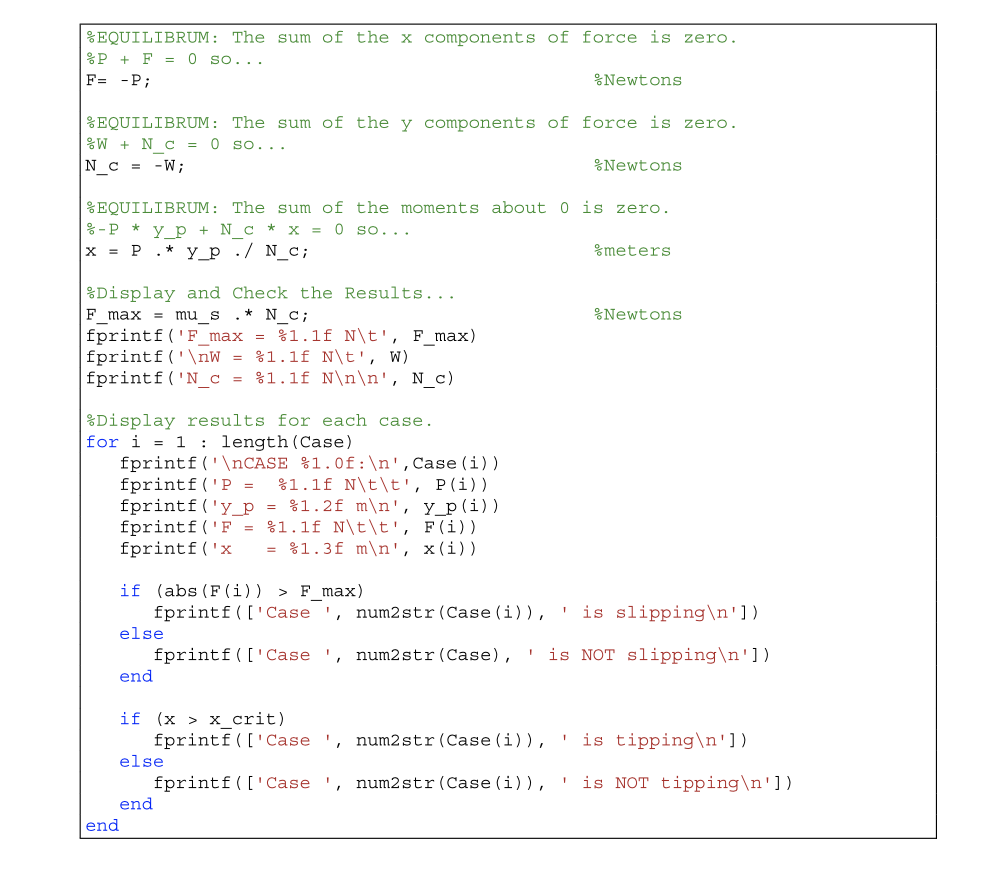
1. Complete the Dry Friction tutorial given in Appendix A from Larsen R. and Hunt S., http://www.secs.oakland.edu/-latcha/EGR280 /StatDynMatlab.pdf This tutorial will guide you through the steps to analyze Pushing a Crate. a) On paper, draw the FBD of the crate and write out the solution in variable form, including equilibrium equations and explanations of friction equations that are used. b) Create the MATLAB script from the tutorial with proper commenting. c) Recreate the table from the tutorial (formatted correctly) to be used in your final report. d) Save files from item 1-b using the following filename formats: Lastname_Firstname_crate.m MATLAB file for crate problem 2. Evaluate the friction problem shown in Figure 1. Figure 1. The 50-lb plate ABCD is attached at A and D to collars that can slide on the vertical rod. Assume that the rod is sufficiently slim that forces on either side of the rod can be considered acting at the same point. Knowing that the coefficient of static friction is 0.40 between both the collars and the rod, determine whether the plate is in equilibrium or will slide in the position shown for the given parameters. The applied force, P, varies from 0 to 50 lb in 10-lb increments. The point of application of the force, x, varies from 3 ft to 5 ft in 1-ft increments. a) On paper, draw the FBD of the plate and write out the solution in variable form, including equilibrium equations and explanations of friction equations that will be used in the MATLAB script. Case 1 2 3 4 ...thru 18 b) Create the MATLAB script by modifying the script created in the tutorial with extensive commenting on the script purpose. c) Save files from item 2-b using the following filename format: Lastname_Firstname_plate.m d) Create a table for results from the 18 cases (formatted correctly) to be used in your final report. Table 1 can be used as an example format. Table 1. Case Study of Plate Connected to Rod Force, P [lb] 0 0 0 5 i. ii. MATLAB file for plate problem iv. Distance, x Normal, NA or NB Friction, FA + FB Friction Max, Fmax_A + F max_A [ft] [lb] [lb] [lb] 3 4 5 3 3. Write a grammatically-correct paragraph that briefly states what was done. Explain what the results tell you. Include and be sure to reference the tables. 4. To Blackboard, submit: a. A single pdf report (named: Lastname_Firstname_project.pdf) containing: Heading with name, course name, project name, section and date. Paragraph that briefly states what was done and explains results. Completed results tables formatted as shown. Scanned copies of FBDs and associated hand calculations for the equations in variable form used to create the MATLAB script. These hand diagrams and calculations should be completed neatly on plain white or engineering paper prior to scanning. Sliding? b. Your MATLAB scripts as identified in 1-d and 2-d. Grading Rubric: /10.0 Proper report heading. Paragraph that states what was done and explains results. /10.0 Generation and completion of crate table in submitted pdf file. /20.0 Generation and completion of plate table in submitted pdf file. /5.0 FBD of crate in submitted pdf file /10.0 Complete and correct variable hand calculations for crate in submitted pdf /10.0 FBD of plate in submitted pdf /20.0 Complete and correct variable hand calculations for crate in submitted pdf Proof of completion of the MATLAB work which includes: 1. Blackboard submission of correct and properly commented crate.m file using specified naming format. 2. Blackboard submission of correct and properly commented plate.m file using specified naming format. /15.0 Items in single pdf file should be in the order listed in this rubric. All files must be submitted to Blackboard by the due date and time for the assignment to be considered on time. -10 points (10%) per day (24 hours) late (Grade of 0 recorded after 48 hours.) Helpful tips: 1. The grading rubric contains additional information for the items to be graded and is provided as a courtesy. 2. At P = 0 and x = 5 ft, plate is in equilibrium. At P = 20 lb and x = 5 ft, plate slides downward. 3. Go to https://www.mathworks.com/learn/tutorials/matlab-onramp.html if you need refreshers on MATLAB basics. 8 Dry Friction Ref: Hibbeler 8.2, Bedford & Fowler: Statics 9.1 To move a heavy crate, such as the one illustrated in the example below, you have to push on it. If you push hard enough to overcome friction, the crate will slide along the floor. But there is the danger that the crate will tip, especially if you push too high on the side of the crate. To better understand the calculations involved with this dry friction problem, and to see how you can check for tipping, we will solve the "sliding a crate" problem for several cases, varying the push height between 0.2 and 1 m, and the magnitude of the pushing force between 100 and 120 N. Example: Pushing a Crate A force, P, is applied to the side of a crate at height yp from the floor. The crate mass is 35 kg, and is 0.5 m wide and 1.0 m in height. The coefficient of static friction is 0.32. For each of the test cases tabulated below, determine: a) the magnitude of the friction force, F, b) the magnitude of the resultant normal force, Nc, and c) the distance, x, (measured from the origin indicated in the illustration below) at which the resultant normal force acts. Once these results have been calculated, check for tipping and/or slipping. Test Cases 1 2 3 4 5 6 7 8 P 100 N 100 N 100 N 100 N 120 N 120 N 120 N 120 N P 0.2 m 0.4 m 0.8 m 1.0 m 0.2 m 0.4 m 0.8 m 1.0 m 0.25 m 0.25 m W O No ||- A-1 1 m Solution, Case 1 First, a free-body diagram is drawn. P >> M = 35; X_crit = 0.25; mu_s = 0.32; g = 9.807; >> %Data from the problem statement... % for specific case: Case = '1'; >> P = 100; y_p = 0.2; >>> % for all cases: = Xcrit 0.25 m Then we calculate the weight of the crate. W = -M * g W = -343.2450 W To start the solution in MATLAB we begin by assigning the values given in the problem statement to variables. F Nc %Newtons %meters %kg %meters %meters/s^2 %Newtons Next, we use the equilibrium condition that the sum of the forces in the x direction must be zero. (This condition holds if the crate is not sliding or tipping.) % P + F = 0 So... >> F= -P F = -100 Then, we use the equilibrium relationship for the y-components of force to determine the resultant normal force, Nc. % W+N_c=0 SO... N_c = -W N_c= 343.2450 The last equilibrium relationship, that the sum of the moments about O must be zero, can be used to determine the location at which Nc acts, called x in the illustration above. % -P *y_p + N_c* x = 0 > x =P*y_p/N_c X = else fprintf(['Case ', Case, 'is NOT slipping ']) end 0.0583 At this point the equilibrium calculations are complete. We can solve for Fmax, the maximum force that can be applied before overcoming friction. If the frictional force, F, exceeds Fmax, then the crate would slip. (As it begins to slip, the equilibrium relationships are no longer valid.) > if (abs(F) > F_max) fprintf(['Case ', Case, 'is slipping ']) SO... %Newtons > if (x > x_crit) fprintf(['Case ', Case, 'is tipping ']) else Case 1 is NOT slipping Note: The absolute value function was used on F since both the magnitude and direction of F (the minus sign) were determined using the equilibrium relationship. Only the magnitude is used to test for slippage. %Newtons Finally, we can check for tipping by testing to see if the calculated x is beyond the edge of the crate (Xcrit). fprintf(['Case ', Case, ' is NOT tipping ']) end Case 1 is NOT tipping %meters Note: The if statements are certainly not required here the test could be performed by inspection - but it is convenient to let MATLAB do the checking for each of the eight cases. From these tests we can see that a push of 100 N applied at a height of 0.2 m will not cause the crate to tip, but it will not cause the crate to move (slip), either. Solution, Case 2 The only change between Case 1 and Case 2 is the height at which the push is applied. In Case 2 yp = 0.4 m. This value is change at the beginning of the MATLAB script, and the script is simply re- executed to calculate the values for Case 2. The complete, annotated script solution for Case 2 is shown below. Annotated MATLAB Script Solution - Case 2 Data from the problem statement... for specific case: Case = '1'; P = 100; Y_P = 0.4; for all cases: M = 35; x_crit = 0.25; mu_s = 0.32; g = 9.807; Pushing a Crate Problem % % % % % Calculate the weight of the crate. W = -M .* g; fprintf(' W = %1.1f N\t\t', W) F = -P; fprintf('F Case 2 Newtons Checking the Results... F_max = mu_s .* N_c; fprintf('F_max = %1.1f N ', F_max) %meters if (abs (F) > F_max) fprintf(['Case ', Case, is slipping ']) %kg %meters %EQUILIBRUM: The sum of the x components of force is zero. %P + F = 0 SO... %meters/s^2 %Newtons = %1.1f N\t\t', F) %EQUILIBRUM: The sum of the y components of force is zero. W + N c = 0 so... |N_C = -W; |fprintf('N_c = %1.1f N ', N_c) Newtons %EQUILIBRUM: The sum of the moments about 0 is zero. -Py_p + N_c * x = 0 so... x = P. y_P ./ N_c; fprintf('x = %1.3f m\t\t', x) %Newtons meters %Newtons % % % % % % % % else end fprintf(['Case ', Case, is NOT slipping ']) if (x > x_crit) fprintf(['Case ', Case, is tipping ']) else end fprintf(['Case ', Case, is NOT tipping ']) Summary of Results for All Eight Cases By repeatedly changing the assigned values for P and yp in the MATLAB script, the results for all cases can be determined. Those results are summarized here. The value Nc = 343.2 N is not case dependent in this problem. Test Cases 1 2 3 1 5 Tip? No No No 100 N Yes 100 N No 120 N No 120 N 120 N Yes Yes 120 N Yes Yes * The calculated result for x has no meaning except to indicate that the crate is tipping if x > X crit- 6 7 8 = 1 P 100 N 100 N 1 0.2 m 0.4 m 0.8 m 1.0 m 0.2 m 0.4 m for all cases: M = 35; x crit = 0.25; mu s = 0.32; g = 9.807; 0.8 m 1.0 m F -100 N -100 N -100 N -100 N -120 N -120 N Annotated MATLAB Script Solution - All Cases -120 N -120 N A faster approach to solving the problem is to define P and ypas vectors and having MATLAB perform all the calculations simultaneously. By default MATLAB performs matrix calculations when using the *, /, and ^ operators. To force MATLAB to perform element-by-element operations place a period in front of the operator. To display the results we can then take advantage of the MATLAB for() statement to loop through the solution vectors and display the results by Case. Pushing a Crate Problem Data from the problem statement... % for specific case: Case = [ 1 2 3 4 5 6 7 8 ]; P X 0.058 m 0.117 m 0.233 m 0.291 m* 0.070 m 0.140 m 0.280 m* 0.350 m* [ 100 100 100 100 120 120 120 120]; Y_P=[ 0.2 0.4 0.8 1.0 0.2 0.4 0.8 1.0]; Calculate the weight of the crate. W = -M.* g; Slip? No No No No Yes Yes % % % % % % - All Cases ? Newtons %meters %kg %meters %meters/s^2 Newtons EQUILIBRUM: The sum of the x components of force is zero. %P + F = 0 so... F= -P; %EQUILIBRUM: The sum of the y components of force is zero. W + N c = 0 so... |N_C = -W; Display and Check the Results... F_max = mu_s * N_C; fprintf('F_max = %1.1f N\t', F_max) fprintf(' W = %1.1f N\t', W) fprintf('N_c = %1.1f N ', N_c) %EQUILIBRUM: The sum of the moments about 0 is zero. -P *y_p + NC * x = 0 so... x = P. y_P ./ N_c; Display results for each case. for i=1: length (Case) fprintf(' CASE %1.0f: ', Case (i)) fprintf('P = %1.1f N\t\t', P(i)) fprintf('y_p = %1.2f m ', y_p(i)) fprintf('F = %1.1f N\t\t', F(i)) fprintf('x = %1.3f m ', x(i)) end if (abs (F(i)) > F_max) fprintf (['Case else %Newtons end if (x > x_crit) fprintf (['Case ' num2str (Case (i)), fprintf(['Case ', num2str (Case (i)), else Newtons num2str (Case (i)), is slipping ']) fprintf(['Case ', num2str (Case), is NOT slipping ']) end %meters Newtons is tipping ']) is NOT tipping '])
Step by Step Solution
There are 3 Steps involved in it
Step: 1

Get Instant Access to Expert-Tailored Solutions
See step-by-step solutions with expert insights and AI powered tools for academic success
Step: 2

Step: 3

Ace Your Homework with AI
Get the answers you need in no time with our AI-driven, step-by-step assistance
Get Started


